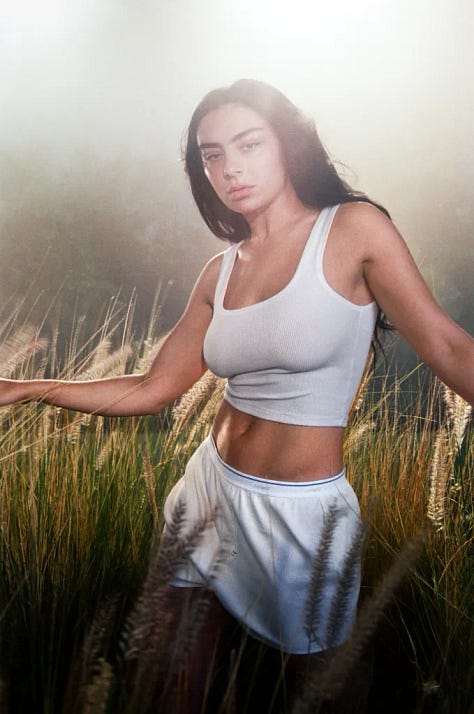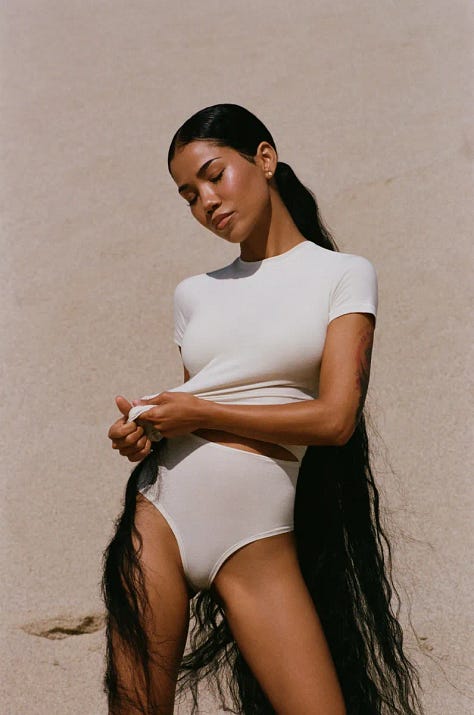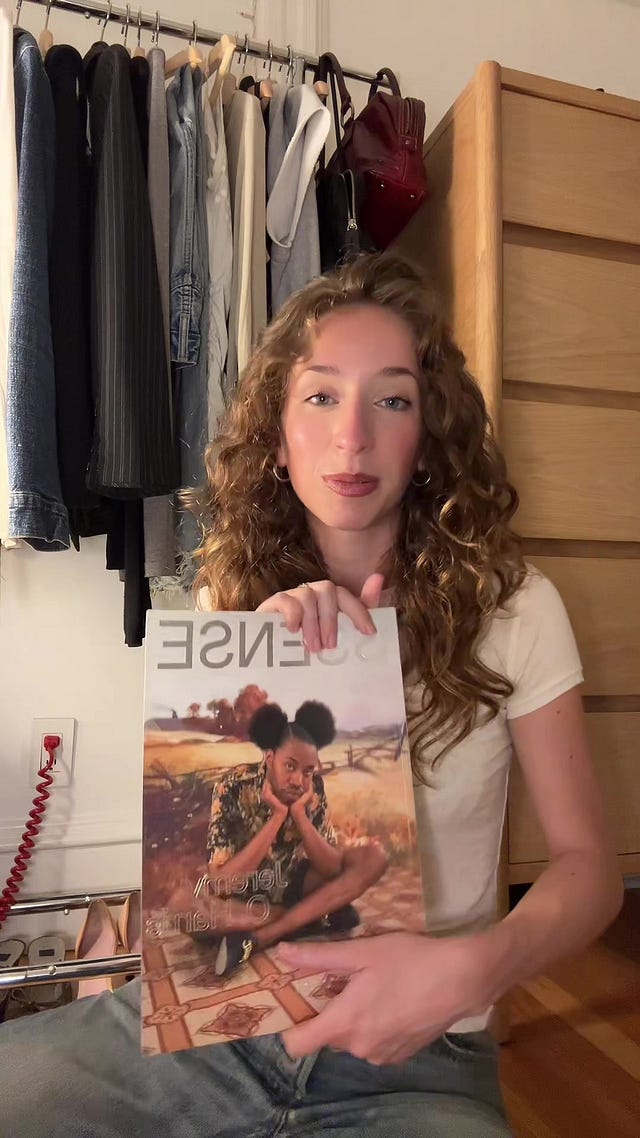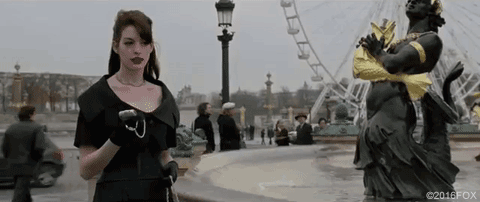is being photographed for SKIMS the new Vogue cover?
and other things I think about while running for the tube
My first boyfriend had an older sister who religiously collected issues of Tatler Magazine - the British Condé Nast title dedicated to documenting high society that now labels itself as the original social media (which is kind of, sort of true). She kept neat stacks of them around her bedroom as they towered over her desk and sat piled above drawers. The sea of perfect white spines and black stamped text displaying the month of each publication had such a profound effect on me all those years ago that I soon started building my very own British Vogue stockpile.
It was like a library I never touched or walked in or looked at after purchase - a bank of fashion starting from the year 2013 that soon became furniture I’d place lamps on when I ran out of shelf space, preserved exclusively for if I ever wanted to go back and reference what people were wearing in May six years ago. I stashed issues at my parent’s house and kept a hoard in my student flat. While studying at university, the college I belonged to had a dedicated room that contained issues of British Vogue going back to the very beginning of the magazine. I would sit with the folios open and scan my favourite pages for hours, looking at old cigarette adverts and reading through articles on fashion advice from before my time.
Whenever I’d stop in a newsagent to buy the most recent copy of Vogue, I’d walk out holding it to my chest feeling like the only person in the world who was about to read those pages. I’d sift through the Prada, Chanel and Stella McCartney double-page spreads, read the Editor’s Letter and see what puns were being used in the ‘trends’ section (example: ‘Bright Ideas’ for a report on bold colours). I’d maybe skip through the cover interview, spritz myself with the god-awful free fragrance that was being pushed and skim over any sponsored sections that fused the latest electric car with fashion. I’d look at every single page. I was signed up to the subscription service and would anticipate receiving the familiar white padded A4 envelope in the post every month from Condé Nast.
“This is just… I don’t even know what this is any more” I remember saying to my best friend when we were still living together, holding the glossy cover in my hands of whatever issue of British Vogue I was flicking through back then “These writers are talking to each other, who’s the target audience, how can you make in-jokes in a mass-marketed magazine?” It wasn’t an instant rejection of the fashion powerhouse, but the candle I’d held so long for the magazine started to fade as if a big jug of water was being dripped onto my dreams from a great height. The illusion they’d sold me, as is shown so well in ‘Confessions of a Shopaholic’ and ‘The Devil Wears Prada’ felt like a far-off experience that was still only attainable if you knew the right people, a fact I’d so desperately wanted to believe wasn’t true. The writers were chatting about their favourite restaurants as if I’d eaten at Chiltern Firehouse ever in my life and sharing out-of-touch fashion hacks that made no sense. The high-production shoots and celebrity features that once felt like a scoop became flat. The same supermodels were plastered on the front pages as they were referred to as “my dear friend” within the magazine copy.
I had a tutor tell me once to never publish a fashion book; “It’ll be obsolete as soon as it hits the shelves” he said. I nodded in agreement from the back of the class while thinking about the fashion books I’d purchased over the years that I still loved to bend the spine of. It’s universally known that print will never move at the pace of social media, as has been so evident in the past few years with TikTok and Instagram have become not only integral to fashion but to journalism too. Vogue’s pivot to YouTube formats (Beauty Secrets) and working to include notable young faces in their content to bring in new consumers (Emma Chamberlain at the Met) has ensured some relevancy as they try to plug the gap they have within their print content. Anna Wintour remains steadfast at the helm of the ship at a seemingly global level, like an all-seeing eye, creating something just special enough that appearing in the magazine is still a coveted moment in a famous person’s career.
But is that all that it is?
 Tiktok failed to load.
Tiktok failed to load.Enable 3rd party cookies or use another browser
I’ve mentioned before on my TikTok that celebrities have a new, internet-friendly press cycle that they move through to help promote the project they’re working on. This includes appearing on things like Hot Ones, Emma Chamerblain’s podcast 'Anything Goes’ and Alex Cooper’s ‘Call Her Daddy’. Another newer part of this “relevancy run” (I just made that up) is appearing in a SKIMS campaign. These simple carousel posts, whether featuring an athlete, influencer or music artist, break the internet every time they’re released. Maybe it’s because they’re able to tap the most significant celebrity of the moment but I think there has to be a method to the social media madness beyond just selling underwear.
This brainwave came to me after seeing yesterday’s images of Charli XCX wearing the soon-to-be-launched SKIMS cotton items, all photographed by cool girl Petra Collins (the director behind most of Olivia Rodrigo’s iconic music videos). The shoot was different. Relevant. Exciting. Perfectly executed. It felt luxe but attainable, fun yet timeless and I’m keen to see which star will be ‘the face’ of SKIMS next. Along with snapping the ‘365’ singer as she reaches full fame, Kim Kardashian and her team have also masterfully worked with gymfluencer Steven Kelly, kitted out USA athletes ahead of the Olympics, shot the dreamiest pictures with Bridgerton’s Nicola Coughlan (courtesy of Elizaveta Porodina) added footballer Jude Bellingham to their notable roster of sporting talent and worked with Jhené Aiko in the desert.



British Vogue (I did like the FKA Twigs cover in April) could never be as bold, as reactive, as risque (is that even the right word?) What’s more, SKIMS is an inclusive brand showcasing a range of body types in their campaigns and offering products that appeal to a diverse consumer base with ease. I sometimes flick through the pages of Vogue and feel like I’m seeing the same faces and silhouettes I saw 10 years ago when I thought being skinny was my one true goal in life. The gaping void in good writing that used to be on Vogue’s pages is being replaced by faster shoots that brands like SKIMS can pull off and achieve virality with.
I’m aware social media campaigns require far fewer ‘bells and whistles’ than a big print shoot with an accompanying 1,000-word essay, taking place in a diner somewhere as the interviewer starts the article with a remark about the celeb's choice of food (reminiscent of an article on Gigi Hadid I read once) but what does Vogue do to stand out? The market is saturated and so many great magazines in print and newer platforms offer richer content comparatively - I’m trying to remember all the publications I boxed up and sent back to my parents when moving house out of fear I wouldn’t have space for them anymore - Tank Magazine, 032c or the Japanese menswear bible Popeye for example, even the ultra-niche ski publication Hard Park (which I bought for £7209120 in magCulture last year) are all beautiful and interesting things to own, to treasure. SSENSE and The Face create luxe online assets and exclusive articles that rival the need to buy the latest issue of British Vogue too.
Maybe the whole thing is just a fantasy, an unwavering institution that doesn’t mind if it’s not reactive because it’s Vogue. They create the table we all want to eat at and we’re happy to settle for scraps to allow the elusive fashion dream to live on ("Oh, don't be ridiculous, Andrea. Everybody wants this. EVERYBODY WANTS TO BE US!”) The magazine will inevitably endure like a Celine Dion song or a vintage bottle of wine that you spend thousands on and grimace while drinking.
I do wonder if the brand name will always mean the same though, and if the 108-year legacy is enough, when all that is left is a series of cover stars to help sell the magazine.
I seem to have created more questions for myself,
Until the next one,
Lory x
P.S. Wanted to say that Vogue Business is really, really good and Lucy Maguire is one of my favourite writers.
P.P.S I always loved Franca Sozzani’s work at Italian Vogue - (watch Franca: Chaos and Creation if you want to cry) I also find it funny that her son is now married to Bee Shaffer (Anna Wintour’s daughter).








